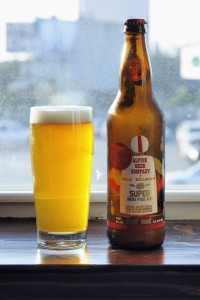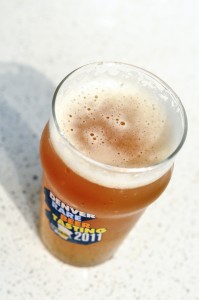
2 sugar pumpkins were heavily roasted yielding about 3 pounds of sweet pumpkin meat that was pulverized and added to the mash.
Update: You can find a full review of this beer, here.
People seem to either love pumpkin beers, or love to hate them. Craft beer drinkers consume them in quantity each fall while a certain segment of ‘beer geeks’ gleefully rant about their disdain for the style and write them off as a trend (oh, the irony). Having been part of this latter group, I can confidently say that my tune has changed. In particular, I look forward to the yearly ritual of consuming high gravity samples like Elysian’s ‘Great Pumpkin’ and the signal of fall these beers represent.
Many craft pumpkin beers feature in-your-face spicing paired with a big residual sweetness. For this beer, I am shooting for something a bit different. While malt-forward, the focus is on toasty bready notes, and less on sweet caramel. This beer features low-spicing — hopefully allowing the heavily roasted pumpkin to shine through. The goal of combining a Maris Otter base with biscuit and honey malts was to produce a graham cracker like character, similar to what is found in pie crust.
Recipe
Size: 2.75 gal
Efficiency: 70%
Attenuation: 72.0% (projected)
Original Gravity: 1.086 SG (Actually hit 1.077 due to pour efficiency)
Terminal Gravity: 1.024 SG (projected)
Color: 16.26 SRM
Alcohol: 8.2% ABV (projected)
Bitterness: 27.9 (projected)
Ingredients:
6.25 lb (65.4%) Maris Otter (Crisp)
1.3125 lb (13.7%) Munich TYPE II (Weyermann)
8 oz (5.2%) Biscuit Malt (Dingeman)
8 oz (5.2%) Flaked Oats (Briess)
6 oz (3.9%) Crystal 45 (Crisp)
6 oz (3.9%) Honey Malt (Gambrinus)
4 oz (2.6%) Belgian Caravienne (Belgian)
3 lb Roasted Sugar Pumpkin
8 g (100.0%) Magnum (14.5%) – added during boil, boiled 90 m
0.5 ea Whirlfloc Tablets (Irish moss) – added during boil, boiled 15 m
0.5 tsp Wyeast Nutrient – added during boil, boiled 10 m
1 ea Cinnamon (Stick) – Whirlpool 10m
.125 tsp Clove (whole) – Whirlpool 10m
.125 tsp Nutmeg (ground) – Whirlpool 10m
WYeast 1056 American Ale™
1 ea Vanilla Bean Soaked in Bourbon (1 bean in 2 oz. bourbon) – Secondary
Mash:
120 °F – 5m (Beta Glucan)
154 °F – 60m (Saccarification)
168 °F – 10m (Mashout)
Yeast Starter:
Final Volume into Fermenter = 2.25 Gallons
Yeast Required = 132 billion (per Mr. Malty)
Yeast Production Date: 8/16/13
Yeast Starter = 1L @ 1.040 on stir plate (per Mr. Malty) = 4 1/8oz. DME
Fermentation:
1. Chill to 60* F and keep at 62* F until activity slows (1 week+).
2. Raise temp to 70*F 2 days
3. Crash to 32*F 5 days





